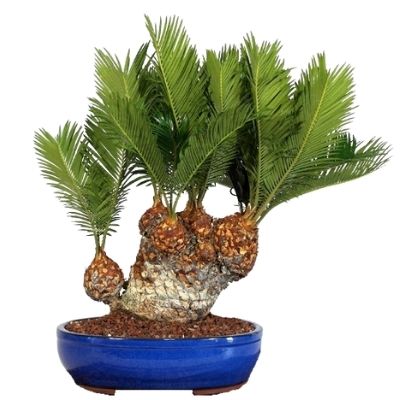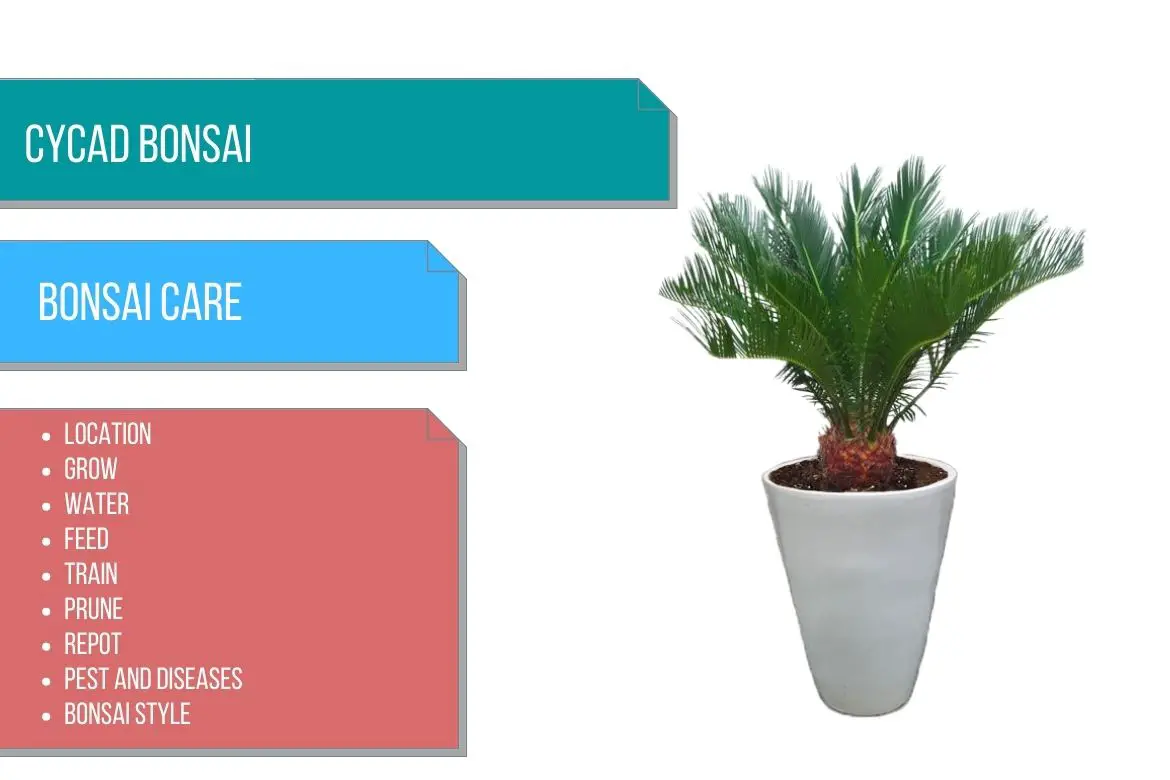
Cycad
(Cycas)
Country of Origin : China and Japan
Bonsai Styles : Clump, multiple-trunk, group, forest, broom, slanting
Zone : 8 – 13
Cycads can be found in all tropical and subtropical regions. The cycad is one of the oldest plants on Earth, which bridges the evolutionary gap between trees and ferns.
Despite the fact that cycads do not adhere to the typical definition of a tree, cycad bonsai beautifully mimics the appearance of a tree in an island. (You can display the pot in a shallow tray filled with moist pebbles to achieve this look)
A caycad plant begins to grow as a bulb-like swelling on the trunk that breaks off and grows roots.
The trunks of the trees grow fat and round at first, before gradually elongating into palm-shaped trunks.
Cycad bonsai was one of the favorites among bonsai enthusiasts of the region where cycad bonsai originated.
Even to Westerners, however, they have a great appeal.
For Cycas bonsai tree, generally three species of cycads are used:
- Cycas revoluta – Also known as king sago or sago palm, this cycas species originated in Japan. This is the most commonly grown Cycas species. This is probably due to its high adaptability and ease of growing from suckers.
- Cycas circinalis – Also known as queen sago, this cycas species is believed to come from southern part of India. After C. circinalis, this species of Cycas is the second most popular species.
- Cycas taigungensis – Also known as Prince sago, this Cycas species is gaining its popularity. The increased popularity can be attributed to its robustness and growth rate.
Note: Even though cycads are called palms and have a similar growth pattern, cycads are not closely related to palms.
In order to miniature the leaves and growth pattern, the roots must be restricted in a bonsai container.
Some experts doubt whether a tree without branches can be a true bonsai, but be that as it may, its ornamental value and interest are undeniable.
Best location to keep Cycad Bonsai
The Cycad bonsai tree is a true tropical tree that thrives in heat and humidity, and cannot tolerate dry conditions.
The more hot and humid it is, the better it is for cycad bonsai tree. They can be kept indoors and will do well even in light levels between 500-1000 Lux. Check out how to grow indoor bonsai trees using grow lights.
Summer is a good time for Cycad bonsai tree to be outdoors in full sun, as long as they have been gradually acclimated.
Avoid making drastic and sudden changes to its location by moving the pot.
If the cycad bonsai tree is kept indoors, make sure that the plant is not exposed to direct sunlight through the window. Provide the bonsai with light shade with the help of drapes.
Many bonsai enthusiasts find that their plants need no shade by placing them in west-facing windows. Refer sunlight requirements for indoor plants for more indoor gardening ideas.
Propagation of Cycad
Cycad can be propagated using root divisions and suckers.
Watering Cycad Bonsai
Water cycad bonsai tree generously in the time of summer.
The plant will lose foliage as soon as it is subjected to dry roots, and it may eventually die.
Keep the bonsai soil moist in the time of winter. In winters, the growth of the cycad bonsai tree slows down. Thus, the uptake of water also reduces.
If the bonsai soil is over-saturated the growth of cycad bonsai might get shunted.
Spray water on the cycad bonsai foliage so as to increase the humid condition around the bonsai tree.
Wiring Cycad Bonsai
Because of the structure and foliage of the cycad bonsai tree, wiring for training the bonsai tree is not possible.
Pruning Cycad Bonsai
When to prune Cycad bonsai?
How to prune Cycad bonsai?
Conventional pruning is not applicable to a cycad bonsai tree since there are no “typical” branches.
Make sure to not pull the dead fronds while pruning. Cut the fronds using a sharp tool as close as possible to the trunk.
To create the diamond-patterned texture of palm tree trunks, make the cut slope downward away from the stem.
Prune the cycad bonsai tree in summer time, so that the tree has enough time to heal the wound before winter comes.
In spring, pruning will promote new growth at the site of the wound.
Pinching Cycad Bonsai
Do not pinch the growing tips of cycad bonsai tree.
Pinching can even result in death of the plant.
A ragged and untidy trunk will result from careless removal of dead fronds.
Repotting Cycad Bonsai
When to repot Cycad bonsai?
Since cycad bonsai tree is very slow growing, repotting cycad bonsai tree can be performed every 5 years or so.
The thick and fleshy roots of cycad are extremely fragile. Repotting should be done with extra care to prevent root damage.
Any root pruning at the time of repotting is strictly prohibited.
Increase the size of the bonsai pot every time you perform repotting of cycad bonsai tree.
You can use a soil mix meant for cactus.
OR
You can use 20% grit and 80% organic matter.
Must Read: Bonsai Soil Recipes
Must read : Choosing the right bonsai container
Feeding Cycad Bonsai
Apply a half strength balanced feed during the summer season. In winters, apply quarter strength balanced feed.
All year long, feed sparingly with a balanced fertilizer, reducing the strength in winter.
Fish emulsion and other mild feeds can be used as instructed. Other products should be used at half strength.
Diseases and pest of Cycad Bonsai
Cycad bonsai trees are pretty much pest free.
However, at times scaled insects can pose little problem.
If water is allowed to stagnate in the bonsai soil or water is too cold, “Damping off” can occur. Damping off is a fungal infection that affects young seedling stems.
Cycad bonsai care
Changes in its local environment can have a significant impact on the cycad bonsai tree.
A sudden drop in local temperatures will cause the fronds to turn yellow and fall.
Reduced light levels, droughts and reduced humidity will also lead to yellowing of fronds.
When this occurs, relocate the cycad bonsai tree to a bright, warm location and keep the roots moist and warm.
What to look for when buying Cycad Bonsai
A cycad bonsai specimen with trunks of varying sizes will eventually make a more interesting bonsai specimen.
When buying a cycad onsai tree, make sure that a healthy growing tip should be visible in the center of the spiral of fronds.
A lack of buds or emerging shoots may indicate drought-induced stunting of the bonsai tree.
You can always recover the plant from this stunted state. However, if you have the choice, avoid investing in such cycad bonsai specimen, as all the extra efforts of nursing the plant back to its healthy state is not worth it.


